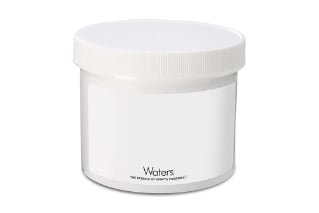
|
Separation Mode |
Reversed Phase |
|
Detection Method |
UV |
|
Formulation |
Liquid |
|
Storage Condition |
Room Temperature |
|
System Type |
LC |
|
Shipping Condition |
Ambient |
|
Volume |
25 mL |
|
Type |
Reagent |
|
UNSPSC |
41116105 |
|
Product Type |
Reagents |
|
Units per Package |
5 pk |

PIC Reagent B7
As the world’s leading manufacturer and supplier of scientific equipment, Waters ensures that you can equip your lab with all the necessary tools to conduct analysis. As such, Waters also has an extensive portfolio that provides a convenient solution for analyzing samples containing ionic species in the Paired -Ion Chromatography (PIC®) Reagents. This is accomplished while eliminating problems of precise pH and temperature control, reproducibility, and short column life associated with ion exchange. These reagents can be used to separate ionic compounds by reverse-phase chromatography, saving time by allowing simultaneous assay of acids, bases, amphoteric and neutral compounds. This particular listing is the PIC Reagent B7, which is a 5 vial per package workable solution in the UV range in the mobile phase of 240+ nm. The reagent has been specially formulated to eliminate background interference in the low UV range.
Paired-ion chromatography is a technique for performing ion-exchange separations on a reversed-phase column by adding hydrophobic paired-ion reagents to the mobile phase that are adsorbed onto the stationary phase. These reagents enhance the interaction of oppositely charged sample components with the stationary phase, delivering multiple benefits, including increasing the retention of oppositely charged solutes, decreasing the retention of equally charged solutes, and not affecting the retention of uncharged solutes.
Employ the PIC Reagent B7 rapid separation of bases, as it helps to easily separate Quaternary amines, a class of compounds that is usually separated by ion-exchange chromatography. The PIC Reagent B7 has been purified and quality controlled by liquid chromatography to guarantee consistent results. In addition to this, it has also been preformulated for ease of use and is buffered to an appropriate pH for most acidic and basic compounds. By using the PIC Reagent B7, you have an increased sensitivity potential for compounds ordinarily used with existing PIC reagents.
Shop for lab equipment to complete your analytical tools collection by selecting the appropriate products from our portfolio, such as the PIC Reagent B5 and other related products that are sure to bring efficiency and optimal solutions to your laboratory.
What Does Ion Exchange Remove?
The ion exchange process is widely used for the removal of hardness (as in softening), heavy metals (as in waste treatment), radionuclides (as from power plants), and municipal water feeds (removal of nitrates, arsenic, perchlorate, hexavalent-chrome, and others).